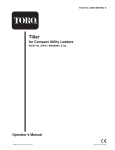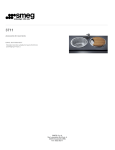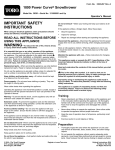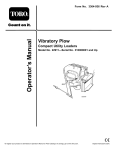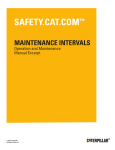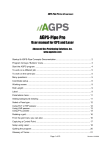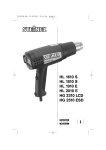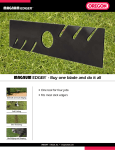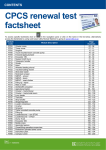Download "user manual"
Transcript
Form No. 3353-890 Rev B High Torque Trencher Head and High Speed Trencher Head for Compact Utility Loaders Model No. 22470—Serial No. 250000001 and Up Model No. 22471—Serial No. 250000001 and Up Register at www.Toro.com. Original Instructions (EN) This manual identifies potential hazards and has safety messages identified by the safety alert symbol (Figure 2), which signals a hazard that may cause serious injury or death if you do not follow the recommended precautions. There may be buried power, gas, and/or telephone lines in the work area. Shock or explosion may occur if you dig into them. Have the property or work area marked for buried lines and do not dig in marked areas. Contact your local marking service or utility company to have the property marked (for example, in the United States, call 811 for the nationwide marking service). Figure 2 1. Safety alert symbol This manual also uses 2 words to highlight information. Important calls attention to special mechanical information and Note emphasizes general information worthy of special attention. Introduction Read this information carefully to learn how to operate and maintain your product properly and to avoid injury and product damage. You are responsible for operating the product properly and safely. Contents Introduction................................................................. 2 Safety ........................................................................... 3 Stability Ratings.................................................... 4 Safety and Instructional Decals ............................. 5 Setup............................................................................ 6 1 Installing the Boom and Digging Chain ............................................................... 6 2 Installing the Safety Bar...................................... 7 3 Installing the Spoils Auger.................................. 7 4 Checking the Bearing Case Lube Level................ 8 Product Overview ........................................................ 9 Specifications ....................................................... 9 Attachments/Accessories..................................... 9 Operation..................................................................... 9 Digging a Trench.................................................. 9 Offsetting the Trencher ........................................ 9 Transporting the Trencher on a Trailer ................ 10 Operating Tips ................................................... 10 Maintenance............................................................... 11 Recommended Maintenance Schedule(s) ................ 11 Greasing the Trencher ........................................ 11 Servicing the Bearing Case Lube ......................... 11 Adjusting Digging Chain Tension ....................... 12 Flipping a Worn Boom ....................................... 12 Replacing the Digging Teeth ............................... 13 Replacing the Drive Sprocket.............................. 13 Storage....................................................................... 14 Troubleshooting......................................................... 15 You may contact Toro directly at www.Toro.com for product and accessory information, help finding a dealer, or to register your product. Whenever you need service, genuine Toro parts, or additional information, contact an Authorized Service Dealer or Toro Customer Service and have the model and serial numbers of your product ready. Figure 1 identifies the location of the model and serial numbers on the product. Write the numbers in the space provided. 1 G008933 Figure 1 1. Model and serial number location Model No. Serial No. © 2008—The Toro® Company 8111 Lyndale Avenue South Bloomington, MN 55420 2 Contact us at www.Toro.com. Printed in the USA. All Rights Reserved Safety When going up or down hill, the machine could overturn if the heavy end is toward the downhill side. Someone may be pinned or seriously injured by the machine if it overturns. Improper use or maintenance by the operator or owner can result in injury. To reduce the potential for injury, comply with these safety instructions and those in the traction unit Operator’s Manual. Always pay attention to the safety alert symbol, which means Caution, Warning, or Danger—personal safety instruction. Failure to comply with the instruction may result in personal injury or death. Operate up and down slopes with the heavy end of the machine uphill. An attached trencher will make the front end heavy. There may be buried power, gas, and/or telephone lines in the work area. Shock or explosion may occur if you dig into them. If you do not fully seat the attachment locking pins in the attachment mount plate holes, the attachment could fall off of the traction unit severely injuring the operator or bystanders. Have the property or work area marked for buried lines and do not dig in marked areas. Contact your local marking service or utility company to have the property marked (for example, in the United States, call 811 for the nationwide marking service). • Ensure that you fully seat the attachment locking pins through the holes in the attachment mount plate before lifting the attachment. • Ensure that the attachment mount plate is free of any dirt or debris that may hinder the connection of the traction unit to the attachment. The moving teeth and auger will severely cut hands, feet, or other body parts. • Refer to your traction unit Operator’s Manual for detailed information on safely connecting an attachment to your traction unit. • Keep hands, feet, and any other part of your body or clothing away from moving teeth, auger, or other parts. • Before adjusting, cleaning, repairing, or inspecting the trencher, lower the trencher to the ground, stop the engine, wait for all moving parts to stop, and remove the key. Hydraulic fluid escaping under pressure can penetrate skin and cause injury. Fluid injected into the skin must be surgically removed within a few hours by a doctor familiar with this form of injury or gangrene may result. • Keep your body and hands away from pin hole leaks or nozzles that eject high pressure hydraulic fluid. When the engine is off, attachments in the raised position can gradually lower. Someone nearby may be pinned or injured by the attachment as it lowers. • Use cardboard or paper to find hydraulic leaks, never use your hands. Always lower the attachment lift each time you shut off the traction unit. 3 Stability Ratings To determine the degree of slope you can traverse with the trencher installed on a traction unit, find the stability rating for the hill position you want to travel in the appropriate table below, then find the degree of slope for the same rating and hill position in the Stability Data section of the traction unit Operator’s Manual. Hydraulic couplers, hydraulic lines/valves, and hydraulic fluid may be hot and can burn you if you touch them. • Wear gloves when operating the hydraulic couplers. • Allow the traction unit to cool before touching hydraulic components. • Do not touch hydraulic fluid spills. Exceeding the maximum recommended slope can cause the traction unit to tip, crushing you or bystanders. Do not drive the traction unit on a slope steeper than the maximum recommended slope, as determined in the following tables and the traction unit Operator’s Manual. Important: If you have a traction unit other than a TX compact utility loader, use the counterweight on the traction unit when using the trencher. Failure to use the counterweight will cause the traction unit to become unstable. Orientation Stability Rating Front Uphill C Rear Uphill D Side Uphill C 4 Safety and Instructional Decals Safety decals and instructions are easily visible to the operator and are located near any area of potential danger. Replace any decal that is damaged or lost. 99-9952 1. Cutting hazard, chain and auger—stay away from moving parts and keep bystanders away from the machine. 2. Warning—stop the engine and remove the key before preforming and maintenance or repairs. 3. Explosion and/or electric shock hazard—do not dig in areas with buried gas or power lines. 99-9953 1. Explosion and/or electric shock hazard—do not dig in areas with buried gas or power lines. 5 Setup Loose Parts Use the chart below to verify that all parts have been shipped. Procedure 1 2 3 4 Description Use Qty. Boom assembly Chain assembly (sold separately) Install the boom and digging chain. Safety bar 1 Install the safety bar. No parts required – Install the spoils auger. No parts required – Check the bearing case lube level. 1 2 1 Installing the Boom and Digging Chain 8 Parts needed for this procedure: Boom assembly 3 4 9 Chain assembly (sold separately) 5 Procedure 6 7 1. Raise the trencher about 6 inches (15 cm) off of the ground. G008934 Figure 3 2. Stop the engine and remove the key. 1. 2. 3. 4. 5. 3. Remove the bolt and nut securing the spoils auger and remove the auger (Figure 3). Save the bolt and nut for future use. Spoils auger Drive sprocket Arm on the drive head Double washer Bolts 6. 7. 8. 9. Jam nut Adjusting bolt Nuts Boom 4. Remove the 2 bolts, nuts, and double washers from the sides of the boom (Figure 3). 5. Loosen the adjusting bolt and jam nut (Figure 3). 6. Slide the boom over the arm on the drive head. 7. Install the 2 bolts, nuts, and double washers removed previously through the boom and arm, but do not tighten them. 8. If the chain is not connected, connect the links by pressing or hammering the clevis pin supplied with the chain through the links. 6 Important: To avoid bending the chain links, place blocks under and between the links when hammering the clevis pin through. 9. Secure the clevis pin with the cotter pin supplied with the chain. 10. Loop the digging chain over the auger drive shaft and onto the drive sprocket, ensuring that the digging teeth point forward on the upper span. 11. Set the upper span of the chain into place on the trencher boom, then wrap the chain around the roller at the end of the boom. 12. Thread the adjustment bolt into the boom and turn it in until there is 1-1/2 to 2-1/2 inches (3.8 to 6.3 cm) of slack in the chain on the bottom span. 13. Thread the jam nut down the adjusting bolt and tighten it securely against the boom. 14. Torque the 2 bolts and nuts securing the boom to 135 to 165 ft-lb (183 to 223 N-m). 2. Using the fasteners removed previously, install the trencher safety bar as illustrated in Figure 4. 3. Torque the bolts and nuts to 190 to 230 ft-lb (257 to 311 N-m). 3 Installing the Spoils Auger No Parts Required Procedure Before operating the trencher, install and position the spoils auger to work correctly with the digging chain configuration you are using. Failure to position the spoils auger correctly may damage the trencher. 1. To install and position the auger, use the bolt and nut removed from the auger previously to secure it in the correct holes, as described in the following list: 2 Note: Refer to Figure 5 when performing this procedure. Installing the Safety Bar • 4 inch (10 cm) chain configuration Parts needed for this procedure: 1 Using the hole closest to the auger blade in the end of the auger with two holes, connect the auger to the inner hole on the shaft. Safety bar • 6 inch (15 cm) chain configuration Procedure Using the hole farthest from the auger blade in the end of the auger with two holes, connect the auger to the inner hole on the shaft. 1. Remove the 3 bolts, washers, and flange nuts from the upper left corner of the trencher frame (Figure 4). 1 2 3 • 8 inch (20 cm) chain configuration Using the end of the auger with one hole, connect the auger to the inner hole on the shaft. • 12 inch (25 or 30 cm) chain configuration Using the end of the auger with one hole, connect the auger to the outer hole on the shaft. 4 G008935 Figure 4 1. Safety bar 2. Washers 3. Bolts 4. Flange nuts 7 3 2 1 5 1 G008940 Figure 6 4 1. Bearing case fill hole plug G008936 Figure 5 1. 2. 3. 4. 5. 4. Remove the plug from the bearing case fill hole (Figure 6). Auger Connect these holes for a 4 inch (10 cm) chain Connect these holes for a 6 inch (15 cm) chain Connect these holes for a 8 inch (20 cm) chain Connect these holes for a 12 inch (30 cm) chain 5. Look in the hole, the level should be up to the bottom of the hole; if not add gear lube until it comes out of the hole. 6. Replace the plug and torque it to 15 to 17 ft-lb (20 to 23 N-m). 2. Torque the bolt and nut to 75 ft-lb (101 N-m). 4 Checking the Bearing Case Lube Level No Parts Required Procedure Before operating the trencher, check to ensure that the bearing case is filled with gear lube. 1. Lower the trencher to the ground on a flat, level surface and tilt it so that the boom is parallel with the ground. 2. Stop the engine and remove the key. 3. Clean the area around the bearing case fill hole plug (Figure 6). 8 Product Overview Operation Specifications Refer to your traction unit Operator’s Manual for more information on installing and removing attachments on your traction unit. Note: Specifications and design are subject to change without notice. Width Length Height Weight Maximum trench depth, 2 ft (61 cm) boom Maximum trench depth, 3 ft (91 cm) boom Important: Always use the traction unit to lift and move the attachment. 35 inches (89 cm) 65 inches (165 cm) 24 inches (61 cm) 390 lb (177 Kg) 29 inches (74 cm)/24 inches (61 cm) at a 65 degree boom angle 42 inches (107 cm)/36 inches (91 cm) at a 65 degree boom angle Digging a Trench 1. If your traction unit has a speed selector, set it to the slow (turtle position), then start the engine. 2. Pull the auxiliary hydraulics lever to the operator grip to engage the trencher. 3. Slowly lower the trencher to the ground so that the boom and chain are parallel to the ground. Attachments/Accessories A selection of Toro approved attachments and accessories are available for use with the machine to enhance and expand its capabilities. Contact your Authorized Service Dealer or Distributor or go to www.Toro.com for a list of all approved attachments and accessories. 4. Begin inserting the nose of the boom and chain into the ground by slowly raising the trencher a few inches off the ground while tilting the nose down into the ground gradually. 5. Once the trencher boom is in the ground at a 45 to 60 degree angle, slowly lower the trencher until the spoils auger is just above the ground. 6. Ensure that all parts of the trencher are functioning correctly. 7. Slowly move the traction unit rearward to extend the trench. Note: If you move too fast, the trencher will stall. If it stalls, raise it slightly, slowly drive forward, or reverse the chain direction momentarily. 8. When finished, raise the trencher and boom out of the trench by tilting the attachment rearward, then stop the trencher by moving the auxiliary hydraulics lever into neutral. Offsetting the Trencher You can move the trencher to the right side of the trencher frame to allow you to trench close to buildings and other obstacles. 1. Lower the trencher to the ground, stop the engine, and disconnect the hydraulic lines from the trencher. 9 Transporting the Trencher on a Trailer Hydraulic fluid escaping under pressure can penetrate skin and cause injury. Fluid injected into the skin must be surgically removed within a few hours by a doctor familiar with this form of injury or gangrene may result. Place the trencher on a trailer or truck capable of carrying it. Securely tie the trencher to the trailer or truck using tie straps appropriate for the weight of the trencher and for highway use. • Keep your body and hands away from pin hole leaks or nozzles that eject high pressure hydraulic fluid. Operating Tips • Clean the area of trash, branches and rocks before trenching to prevent equipment damage. • Use cardboard or paper to find hydraulic leaks, never use your hands. • Always begin trenching with the slowest ground speed possible. Increase speed if conditions permit. 2. Remove the 6 bolts securing the trencher head to the frame (Figure 7). • Always use full throttle (maximum engine speed) when trenching. 2 • Always trench backwards (i.e., in reverse). • Never transport the trencher with the loader arms raised. Keep the arms lowered and the trencher tilted up. 3 • When trenching, the spoils auger should just clear the original ground surface to obtain maximum soil removal. 1 G008937 • Trench at a 45 to 60 degree angle for best results. Figure 7 1. Trencher head (simplified for illustrative purposes) 2. Safety bar • You will be able to dig a trench faster by controlling the depth with periodic adjustments of the loader arms. 3. Side hose guide • If your traction unit has a speed selector (present on some wheeled traction units), set it to the slow (turtle position). 3. Move the frame to the left, aligning the holes in the right side of the frame with those in the head. 4. Attach the head to the frame with the 6 bolts removed previously (Figure 7). • If your traction unit has a flow divider (present on some wheeled traction units), adjust it to approximately the 10 o’clock position. 5. Torque the bolts to 190 to 230 ft-lb (257 to 311 N-m). • If the trencher binds in the soil, push the auxiliary hydraulics lever fully forward to reverse the chain direction. Once the chain is loose, pull the lever rearward again and continue trenching. 6. Remove the 3 bolts, washers, and flange nuts from the safety bar and remove the bar (Figure 7). 7. Remove the 2 short bolts, washers, and flange nuts securing the right side of the upper frame and move them to the corresponding holes on the left (Figure 7). • If you need the finished trench to be cleaner than what is possible with the trencher, you can purchase a crumber from your dealer. The crumber mounts onto the trencher and scrapes the trench clean as you run the trencher. 8. Install the safety bar over the trencher chain using the 3 bolts, washers, and flange nuts removed previously (Figure 7). • To improve the quality of trenches less than 24 inches (61 cm) deep, use a 24 inch (61 cm) boom on the trencher. 9. Torque all 5 bolts and nuts to 190 to 230 ft-lb (257 to 311 N-m). 10. Move the hoses from the hose guide on top of the trencher to the hose guide on the left side (Figure 7). 10 Maintenance Recommended Maintenance Schedule(s) Maintenance Service Interval Before each use or daily Maintenance Procedure • Grease the trencher. • Inspect the digging teeth and chain for excessive wear. Every 25 hours • Check the gear lube level. • Adjust the digging chain tension. • Inspect the boom for wear. Every 200 hours • Change the gear lube. • Grease the trencher. • Check the gear lube level. • Paint chipped surfaces. Before storage If you leave the key in the ignition switch, someone could start the engine. Accidental starting of the engine could seriously injure you or other bystanders. Remove the key from the ignition switch before you do any maintenance. Greasing the Trencher Service Interval: Before each use or daily Before storage Grease 2 fittings, as shown in Figure 8 and Figure 9, every day and immediately after every washing. Grease Type: General-purpose grease G008939 Figure 9 1. Stop the engine and remove the key. 2. Clean the grease fittings with a rag. 3. Connect a grease gun to each fitting. Servicing the Bearing Case Lube 4. Pump grease into the fittings until grease begins to ooze out of the bearings. 5. Wipe up any excess grease. Service Interval: Every 25 hours Every 200 hours Before storage Gear lube type: SAE 90-140 API service GL-4 or GL-5 Refill capacity: 1 pint (1/2 l). Checking the Bearing Case Lube G008938 1. Lower the trencher to the ground on a flat, level surface and tilt it so that the boom is parallel with the ground. Figure 8 11 Adjusting Digging Chain Tension 2. Stop the engine and remove the key. 3. Clean the area around the bearing case fill hole plug (Figure 10). Service Interval: Every 25 hours With the trencher parallel to the ground, ensure that there are 1-1/2 to 2-1/2 inches (3.8 to 6.3 cm) between the bottom of the boom and the top of the bottom chain span. If not, adjust the chain using the following procedure: Important: Do not over tighten the chain. Excess chain tension may damage drive components. 1. Loosen the 2 bolts and nuts securing the boom to the trencher arm (Figure 3). 2. Loosen the jam nut securing the adjustment bolt (Figure 3). 3. Turn the adjustment bolt in or out as needed to achieve the desired tension. 4. Tighten the jam nut. 1 5. Torque the 2 bolts and nuts securing the boom to 135 to 165 ft-lb (183 to 223 N-m). G008940 Figure 10 1. Bearing case fill hole plug Flipping a Worn Boom 4. Remove the plug from the bearing case fill hole (Figure 10). Service Interval: Every 25 hours Inspect the bottom of the boom for wear, if it is worn, complete the following: 5. Look in the hole, the level should be up to the bottom of the hole; if not add gear lube until it comes out of the hole. Note: If you have already flipped the boom once, replace the boom when both sides are worn. 6. Replace the plug and torque it to 15 to 17 ft-lb (20 to 23 N-m). 1. Remove the 2 bolts and nuts securing the boom to the trencher arm (Figure 3). Changing the Gear Lube 2. Loosen the jam nut on the adjusting bolt in the boom (Figure 3). 1. Clean the area around the bearing case fill hole plug (Figure 10). 3. Loosen the adjusting bolt until you can remove the chain from the boom (Figure 3). 2. Remove the plug from the bearing case fill hole (Figure 10). 4. Remove the chain from the drive sprocket. 3. Lift the trencher until the boom is vertical, draining the lube through the fill hole and into a pan. 4. Return the trencher to the ground. 5. Remove the boom, flip it over so the bottom becomes the top (or if you have already flipped it once, replace it), and install the boom again. 5. Fill the bearing case with gear lube until it comes out of the fill hole. 6. Replace the nuts, bolts, and washers securing the boom. 6. Replace the plug and torque it to 15 to 17 ft-lb (20 to 23 N-m). 7. Install the chain over the drive sprocket and front roller. 8. Adjust the chain tension as described in Adjusting the Digging Chain Tension. 12 Replacing the Digging Teeth Important: The arrow on the sprocket face should be visible from the right side of the trencher and should point in a clockwise direction; if not, turn the sprocket around. Service Interval: Before each use or daily Due to the high amount of wear placed on the digging teeth, you will need to replace them periodically. 12. Thread the 6 bolts into the sprocket finger tight (Fig. 8). To replace a single tooth, remove the bolts securing the tooth to remove it, then install a new tooth in the same position. Torque the bolts securing the teeth to 27 to 33 ft-lb (37 to 45 N-m). 13. Slowly begin tightening the bolts progressing around the sprocket until all bolts are torqued to 95 to 115 ft-lb (129 to 155 N-m). Important: Tighten each bolt only half way first, working your way around the six bolts, then return to each bolt in turn and torque them to the specifications given in step 13. Replacing the Drive Sprocket Overtime, the drive sprocket will wear, especially when used in sandy or clay soils. When this happens, the digging chain will begin to slip. If the chain slips, replace the drive sprocket, as follows: 1. Raise the trencher a few inches above the ground. 2. Stop the engine and remove the key. 3. Remove the spoils auger (Fig. 8). 14. Loop the chain over the auger drive shaft and onto the drive sprocket, ensuring that the teeth point forward on the upper span. 15. Set the upper span of the chain into place on the trencher boom, then wrap the chain around the roller at the end of the boom. 16. Thread the adjustment bolt into the boom and turn it in until there is 1-1/2 to 2-1/2 inches (3.8 to 6.3 cm) of slack in the chain on the bottom span. 17. Thread the jam nut down the adjusting bolt and tighten it securely against the boom. 18. Torque the 2 bolts and nuts securing the boom to 135 to 165 ft-lb (183 to 223 N-m). 19. Install the spoils auger; refer to Installing the Spoils Auger. 1 2 3 G008941 Figure 11 1. Spoils auger 2. Drive sprocket 3. Bolts 4. Loosen the 2 bolts and nuts securing the boom to the trencher arm (Fig. 2). 5. Loosen the jam nut on the adjusting bolt in the boom (Fig. 2). 6. Loosen the adjusting bolt until you can remove the chain from the boom (Fig. 2). 7. Remove the chain from the drive sprocket. 8. Remove the 6 bolts securing the drive sprocket (Fig. 8). 9. Remove and discard the drive sprocket (Fig. 8). 10. Clean the sprocket mounting surface on the trencher. 11. Slide the new sprocket onto the shaft as illustrated in Figure 8. 13 Storage 1. Before long term storage, brush the dirt from the attachment. 2. Check the condition of the digging chain. Adjust and lubricate the chain. Replace any worn or damaged teeth. 3. Check and tighten all bolts, nuts, and screws. Repair or replace any part that is damaged or worn. 4. Ensure that all hydraulic couplers are connected together to prevent contamination of the hydraulic system. 5. Paint all scratched or bare metal surfaces. Paint is available from your Authorized Service Dealer. 6. Store the trencher in a clean, dry garage or storage area. Cover the trencher to protect it and keep it clean. 14 Troubleshooting Problem The chain does not turn. Possible Cause 1. A hydraulic coupler is not completely connected. 1. Check and tighten all couplers. 2. A hydraulic coupler is damaged. 3. There is an obstruction in a hydraulic hose 4. An auxiliary valve on the traction unit is not opening. 5. The boom end bearing failed. 6. The digging chain is too tight. 7. There is sand buildup in tooth root of the drive sprocket. 2. Check/replace couplers 3. Find and remove the obstruction. 8. Hydraulic motor or chain drive failure The trencher does not dig fast enough. The chain turns in the wrong direction The bearing case lube is contaminated. Corrective Action 4. Repair the valve. 5. Replace the bearing. 6. Adjust the digging chain. 7. Raise the trencher and run the chain backwards, then reduce the chain tension. 8. Contact your Authorized Service Dealer. 1. Worn teeth 1. Replace any worn teeth. 2. Wrong setting on flow divider and speed lever (applicable wheeled units only) 3. There is a restriction in a quick coupler or hose. 4. The hydraulic system is too hot. 5. The relief valve is set below specifications. 2. Set the flow divider to the 10:00 position and the speed lever to the turtle position. 3. Check the hoses and couplers and repair any problems found. 4. Shutdown and allow the system to cool. 5. Contact your Authorized Service Dealer. 1. The auxiliary valve lever is in the wrong position. 1. Move the auxiliary valve lever to the rearward position. 2. The hydraulic hoses are reversed. 2. Disconnect hoses and switch positions. 1. The fill plug is leaking. 1. Look for moisture around the fill plug. If present, change the oil, and replace the plug and the plug o-ring. 2. O-ring failure on the motor. 2. Contact your Authorized Service Dealer. 3. Contact your Authorized Service Dealer. 3. Seal failure. 15 Toro Compact Utility Equipment Warranty CUE Products A One-Year Limited Warranty Conditions and Products Covered The Toro® Company and its affiliate, Toro Warranty Company, pursuant to an agreement between them, jointly warrant your Toro Compact Utility Equipment (“Product”) to be free from defects in materials or workmanship. The following time periods apply from the date of purchase: Products Loaders, Trenchers and Attachments Kohler Engines All other Engines Warranty Period 1 year or 1000 operating hours, whichever occurs first 3 years 2 years Where a warrantable condition exists, we will repair the Product at no cost to you including diagnosis, labor, and parts. Instructions for Obtaining Warranty Service If you think that your Toro Product contains a defect in materials or workmanship, follow this procedure: 1. Contact any Authorized Toro Compact Utility Equipment (CUE) Service Dealer to arrange service at their dealership. To locate a dealer convenient to you, access our website at www.Toro.com. You may also call our Toro Customer Care Department toll free at 888-865-5676 (U.S. customers) or 888-865-5691 (Canadian customers). 2. Bring the product and your proof of purchase (sales receipt) to the Service Dealer. If for any reason you are dissatisfied with the Service Dealer’s analysis or with the assistance provided, contact us at: LCB Customer Service Department Toro Warranty Company 8111 Lyndale Avenue South Bloomington, MN 55420-1196 Toll Free: 888-865-5676 (U.S. customers) Toll Free: 888-865-5691 (Canada customers) Owner Responsibilities You must maintain your Toro Product by following the maintenance procedures described in the Operator’s Manual. Such routine maintenance, whether performed by a dealer or by you, is at your expense. Parts scheduled for replacement as required maintenance (“Maintenance Parts”), are warranted for the period of time up to the scheduled replacement time for that part. Failure to perform required maintenance and adjustments can be grounds for disallowing a warranty claim. Items and Conditions Not Covered Not all product failures or malfunctions that occur during the warranty period are defects in materials or workmanship. This express warranty does not cover the following: • Product failures which result from the use of non-Toro replacement parts, or from installation and use of add-on, modified, or unapproved accessories • Product failures which result from failure to perform required maintenance and/or adjustments • Product failures which result from operating the Product in an abusive, negligent or reckless manner • Parts subject to consumption through use unless found to be defective. Examples of parts which are consumed, or used up, during normal Product operation include, but are not limited to, digging teeth, tines, spark plugs, tires, tracks, filters, chains, etc. • Failures caused by outside influence. Items considered to be outside influence include, but are not limited to, weather, storage practices, contamination, use of unapproved coolants, lubricants, additives, or chemicals, etc. • Normal “wear and tear” items. Normal “wear and tear” includes, but is not limited to, worn painted surfaces, scratched decals or windows, etc • Any component covered by a separate manufacturer’s warranty • Pickup and delivery charges General Conditions Repair by an Authorized Toro Compact Utility Equipment (CUE) Service Dealer is your sole remedy under this warranty. Neither The Toro® Company nor Toro Warranty Company is liable for indirect, incidental or consequential damages in connection with the use of the Toro Products covered by this warranty, including any cost or expense of providing substitute equipment or service during reasonable periods of malfunction or non-use pending completion of repairs under this warranty. All implied warranties of merchantability and fitness for use are limited to the duration of this express warranty. Some states do not allow exclusions of incidental or consequential damages, or limitations on how long an implied warranty lasts, so the above exclusions and limitations may not apply to you. This warranty gives you specific legal rights, and you may also have other rights which vary from state to state. Except for the engine warranty coverage and the Emissions warranty referenced below, if applicable, there is no other express warranty. The Emissions Control System on your Product may be covered by a separate warranty meeting requirements established by the U.S. Environmental Protection Agency (EPA) or the California Air Resources Board (CARB). The hour limitations set forth above do not apply to the Emissions Control System Warranty. Refer to the California Emission Control Warranty Statement printed in you operator’s manual or contained in the engine manufacturer’s documentation for details. Countries Other than the United States or Canada Customers who have purchased Toro products exported from the United States or Canada should contact their Toro Distributor (Dealer) to obtain guarantee policies for your country, province, or state. If for any reason you are dissatisfied with your Distributor’s service or have difficulty obtaining guarantee information, contact the Toro importer. If all other remedies fail, you may contact us at Toro Warranty Company. Part Number 374-0198 Rev. A
















